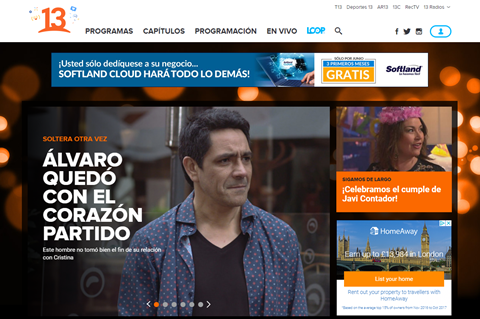With increased competition the distinct advantages enjoyed by OTT providers in the battle for audience attention are wearing a bit thin. Now they must innovate to thrive.
A decade ago, the idea that consumers should decide when and where to watch something was an aspiration. Today OTT video is a reality. More to the point, it is a highly competitive reality.

Akamai Technologies Director of Product Marketing Ian Munford says: “We are coming to a point of saturation in terms of entertainment options. It’s no longer possible to just turn on an OTT service and capture a share of attention, especially since the competition is fierce.
“Distributors are responding to this in many ways,” he adds. “We expect to see innovation continue in delivering a better-than-TV experience, especially on connected TVs, which is the battleground on which the fight for audience attention will be played out.”
But even if smart TVs are the main battleground, OTT providers will have to format content for a whole range of devices. Frequently international businesses, they will also have to address multiple language versions.
Cantemo CEO Parham Azimi says: “Where that gets complicated is ensuring that the right piece of content goes to the right platform, region, and so on. It can be an extremely laborious process, and easy to get wrong.”
The implication of this is that there is a whole new layer of metadata, which in turn calls for a significant expansion of the capabilities of the asset management system.
Tedial Vice President of Products Jérôme Wauthoz says: “OTT special requirements demand unique integrations with the various end users, continuous format adjustments and extensions, and of course support for variable rate playback to adapt to bandwidth capacity issues on the fly.”
Watch Jérôme Wauthoz speaks on IBC365’s webinar, Transforming live sports production with Artificial Intelligence.
Push and pull
Beyond the technical requirements, there are two other critical layers for OTT services: dynamic advertising based on the consumer’s individual profile, and recommendations for future viewing.
The original view that consumers would not accept advertising in OTT video is now widely regarded as commercial suicide: the revenues are too valuable for a successful service. “Broadcasters are developing new and innovative ways to drive value from their content using ad tech,” says Akamai’s Munford.
What is vital is that advertising added to an OTT stream is relevant at the point of delivery. That means it is timely, it is geographically appropriate, and if possible, it is targeted to the individual subscriber. Technology like Yospace can seamlessly stitch advertising into any stream at the point of delivery.

By targeting the advertising to the individual, it becomes more relevant and engaging. Yospace client Canal 13 in Chile saw an average 98.7% view-through rate, according to its Digital Director Rodrigo Torrealba Ruiz-Tagle, “which is just incredible” he adds.
Parham Azimi of Cantemo develops the idea: “One of the biggest selling points of OTT is the fact that it can serve targeted and personalised recommendations to a user based on that user’s profile, preferences and viewing habits.
“Targeted video content is significantly more effective when it comes to engaging views and keeping their attention. User behaviour and profiling is key to content personalisation – and is quite the hot topic right now.”
The result is that a successful OTT provider is dealing in a huge amount of data.
Jérôme Wauthoz of Tedial defines three key requirements for a successful system: “First, virtualisation. Systems must be designed to scale with no bottlenecks, and the flexibility to adapt to new infrastructure models.

“Second, automation – the ability to automate the delivery process has freed up technical labour and helped drive innovation,” he continues. “Third, AI and machine learning. These are key to driving new developments, as they help to automate processes.
“From a pure OTT perspective, AI is key to generate automatic advertisements, content classification and dynamic adaptation of content based on audience preferences,” he adds. “AI is a great solution to target the right audiences with the right content, delivered with adapted ads and sponsorship.”
Which suggests that existing asset management technology will quickly be left behind. Does this mean massive reinvestment?
“For many providers, simply getting rid of a well-functioning, and often complex, on-premise infrastructure is not an option and would be counter-intuitive,” suggests Parham Azimi. “Eventually, most MAMs will have to have some level of AI capability. Currently, this is predominantly the agile MAMs that have been able to begin implementation.”
High-level assets
Wauthoz has already raised the idea of virtualising the asset management system, which leads naturally to the suggestion that it all be implemented in the cloud.
“Many OTT providers have been moving their media workflows to the cloud,” according to Munford. “This is predominantly driven by the desire to build cost efficiencies into their workflows and improve service dynamics or scale.”
Azimi takes up the point. “One of the many benefits of the cloud is elasticity, primarily the freedom to scale up almost every module of the service during times of demand. With a truly efficient media management solution, the management layer takes control in such a way that the complex workflows are as transparent to the user as possible.”

Tedial says that more than 50% of its new clients are implementing their systems on cloud-based infrastructure. Wauthoz raises another issue, though.
“Customers are highly focused on security when it comes to the cloud,” he says. “If for previous, on-premises installations these concerns were mainly their responsibility, now with new cloud-based installations security becomes the concern of every system provider.
“This is changing the way that manufacturers like Tedial build and design their system infrastructure, to guarantee the highest level of security to their customers.”
The over-riding message seems to be that to provide a service which is engaging for consumers, responsive to market change and commercially viable in costs and revenues demands a high level of automation. To achieve that automation means expanding the amount of data you manage on your content and on your subscribers.
“The future of broadcast will be a metadata-driven world, and the companies that succeed will be the ones who understand how to monetise metadata,” Wauthoz says.
“OTT is obviously in the centre of this metadata driven world. Data analysis, personalisation and monetisation will be the key for OTT operators. Success will depend on innovation in metadata management with the help of powerful media processing software systems.”





















No comments yet